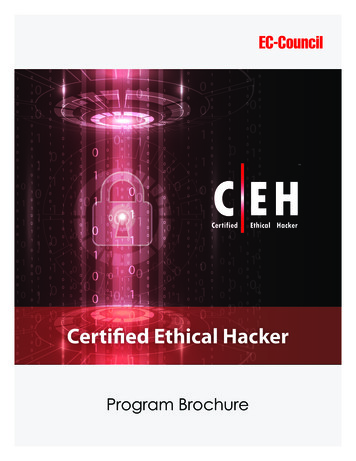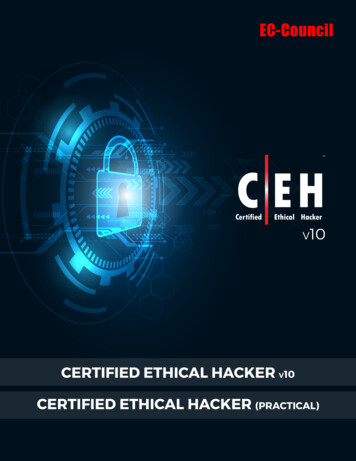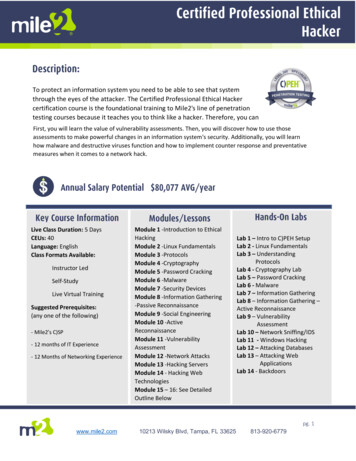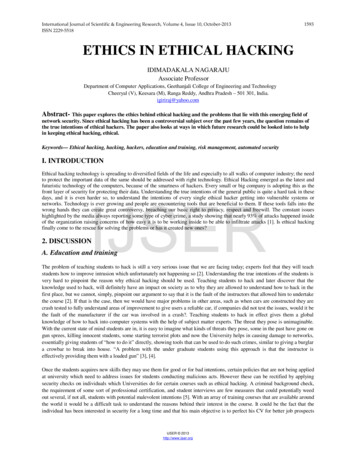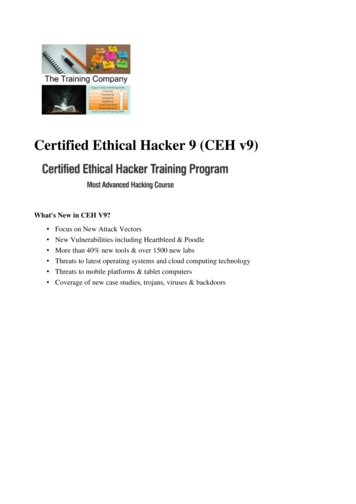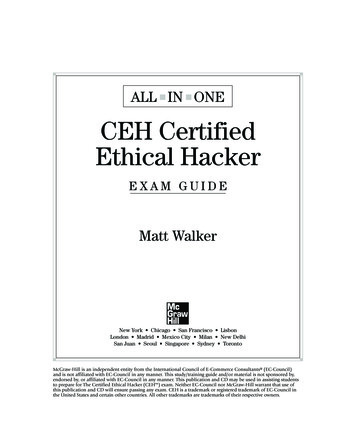
Transcription
workshopscertified ethicalhackerRaheel Ahmad
Hakin9 Magazine Certified Ethical HackerMaster HackingTechnologies and BePrepared for CEH CertificateHakin9’s Hack the Box Series is our first workshop that will help you become a Certified EthicalHacker. It consists of 12 online Modules including 3 Hacking Challenges. You will learn how tobecome a certified ethical hacker with hands-on experience in hacking, exploiting the vulnerabilitiesand rooting the system.Modules Outline: 2Module 01 – Base KnowledgeModule 02 – Building Blocks for Penetration TestingModule 03 – Hack the Face ValueModule 04 – Master Your Scanning SkillsModule 05 – Hack in the Web BoxModule 06 – Buffer Overflows Exploits OverviewModule 07 – Vulnerability Discovery & ResearchModule 08 – Mastering the Metasploit Framework (360 Degree)Module 09 – Hack the Box Basic ChallengeModule 10 – Hack the Box Intermediate ChallengeModule 11 – Hack the Box Expert ChallengeModule 12 – Write Penetration Testing ReportHakin9 – Ethical Hacking Lab AccessThe first 100 subscribers will be provided with access to Hakin9’s Ethical Hacking Lab Environment,which is fully equipped with cutting edge hacking tools for you to master your hacking skills.Hakin9 Magazine
Certified Ethical Hacker Hakin9 MagazineIntroductionHacking has always been an interesting topic for new comers to the field of information technologyand information security. It is difficult to imagine the total number of computer science graduateswho starts their careers in the field of information technology; however, it is possible to count theindividuals who have reached a real success. The question is, why are there so so few survivors?The answer is simple! If you want to be successful in information security, you need to have somethingthat no other individual can present at the same time and with the same level of competence.The tutorials of “Hakin9 – how to become a certified ethical hacker” will give you theoretical and practicalknowledge on how to become a real White Hat security professional, as well as how to prepare yourselffor the ethical hacking certification.What we will coverIf you have a look at the current requirements for the ethical hacking certification, you will see that itis very wide and covers hundreds of topics; however, it is clear that:“This course will significantly benefit security officers, auditors, security professionals, siteadministrators, and anyone who is concerned about the integrity of the network infrastructure”The course will not teach you how to work with a computer, or how TCP/IP protocol operates. It willteach you how to hack systems and will help you understand the mechanism around it. You shouldalready have the basic knowledge of computer systems, networking, servers and web applications.3 Hakin9 Magazine
Hakin9 Magazine Certified Ethical HackerModule 01Base KnowledgeBe EthicalWe our trainees to be ethical and not to use the training tutorials and lab access for any illlegalactivities. According to the law of different countries, any damage or illlegal act can lead to financialpenalties or imprisonment.CertificationOur ethical hacker tutorials will prepare you for the EC Council CEH Certification theoretically,while the lab access will provide you with real environment for practicing the concepts coveredby the tutorials. Nevertheless, we will mostly focus on the hands-on and core of ethical hackingcertifications requirement.What’s not includedThese tutorials will not strictly cover the topic-by-topic learning as it is written in the official slide.Nonetheless, you will receive the most required expertise and security concepts that will help youbecome a certified ethical hacker!Lab AccessYou will be provided with the lab access to the hand-on hacking materials in the hakin9-ethicalhacking lab environment, geared with industry standard of the ethical hacking tools.This would be solely for the use in education purposes.4Who is a hacker?Any individual who illegally breaks or attempts to break any security measures in order to get anaccess or authorization to the system, to which he or she doesn’t have any connection.Nowadays, information security industry has categorized these types of individuals according to theirtheir goals.Types of HackersGenerally, information security industry divides hackers into three types:Black HatsThe experts in computer security with wide range of extra ordinary computer hacking and crackingskills. Their goals are always destructive or malicious. They are also called ‘crackers’ and usually,offensive by nature.Gray HatsThe security experts have a wide range of information security experience and computer hackingskills. Their goal in not always destructive. They may work both, offensively and defensively. Theymay be placed between white hats and black hats.Sometimes, they find bugs & vulnerabilities in various applications and systems, and directly reportto the vendors to help them to improve their security.White HatsInformation security professionals who have gained experience, skills and industry recognitionthrough their cooperation with different vendors. They are usually hired by different organizations.They are certified ethical hackers and always defensive by nature.Hakin9 Magazine
Certified Ethical Hacker Hakin9 MagazineIn the information security industry, there are also other types of hackers: Script kiddies (unskilled hackers who only use scripts and tools)Spy hackers (insiders hired by organizations for penetrating systems)Suicide hackers (aim to bring down critical systems and are not worried of facing 30 years in jail)Cyber terrorists (groups formed by terrorists organizations)State sponsored hackers (formed by governments to gain access to sensitive information of othergovernments)HacktivismHacktivism in defined as anything in hacking, which has a political agenda. It can be performed by anytype of hackers with the exception of white hats. An individual who performs such an act is termed as ahacktivist. So far, in our tutorial, we have presented the key information on different types of hackers andthe main goals of hacking. At this stage, it’s pretty much clear that you want to be a White Hat Hacker.Lets move forward to the next level.Nowadays, to become a certified ethical hacker is not an easy task. You should have enoughexperience in IT Security area of knowledge and should be up to date with the current IT Securitypractices. Why? Because organizations believe that YOU will protect them from malicious hackers!Pre-requisitesEthical hacking is the real time hacking which is legally performed by security professionals withthe aim of finding bugs and vulnerabilities in organizations. Hence, an ethical hacker should bean expert in computer networks, application security, networking concepts and other informationsecurity concepts. Last but not least, the hands-on experience in Windows and Linux environment,altogether with the networking operating systems, will help you become a good security professional.Hackers MethodologyMany books will provide you with different methodologies and frameworks on how to hack; or simply,how to perform penetration testing.5Lets look at the hacking phasesThe five key hacking phases make the complete cycle of how hacking occurs and how a hackersteals, or performs g AccessMaintaining AccessClearing Tracks Hakin9 Magazine
Hakin9 Magazine Certified Ethical HackerNevertheless, these are the set phases and every hacker has his own way of hacking into systems.The main idea of presenting the hacking process is to show you how exactly hacking is performed.Essential terminologies in Information SecurityBefore we start explaining the hacking phases, let’s have a look at the following key IT Securityterminologies, which are widely used and important for understanding the overall hacking cycle.The CIA TriangleIn the field of information security, CIA stands for Confidentiality, Integrity and Availability.ConfidentialityIt is the assurance that the information that is supposed to be accessed only by specific individualsis, actually, only accessible to those people.Integrity6Information is accurate, unchanged and reliable.AvailabilityIt is the assurance that systems, applications, resources and data are available on request. In realworld, hackers do target the CIA triangle in order to either access the necessary information, or createdowntime and make resources unavailable. They may compromise the integrity of the resources andinformation, which lead to compromising the CIA triangle of the entity.Essential terminologies in HackingIt is very important for an ethical hacker to have a deep understanding of the following issues: VulnerabilitiesThreatsExploitsPayloadsZero-day attackWhat is Vulnerability?Vulnerability is generally defined as the weakness in a system. It could be in the design, source ofthe application, configuration of the IT environment, including people –processes – technologies.What is Threat?It is a combination of vulnerability and the motivation factors. Threat is also defined as a set of anycircumstances or processes that lead to disastrous outcomes.What is Exploit?A malicious piece of software code that is written to gain an illegitimate access to the IT environment.Exploits are written to use the weakness of the respective environment. It is simply designed in a way tobreak the information security controls.Hakin9 Magazine
Certified Ethical Hacker Hakin9 MagazineWhat is a payload?A payload is simply a part of an exploit; it is an actual piece of code that is written to perform specifictasks.What is Zero-Day attack?An attack in which the hacker exploits a certain vulnerability before launching any patch from thevendor for this vulnerability.The phases of Ethical HackingThese are the various phases of hacking:1) Reconnaissance – the preparatory phaseReconnaissance is the information-gathering phase in the ethical hacking phases cycle. In this phase,Hackers collect as much information about the target as possible. They learn more about the target andprepare strategy for the next phases.Types of reconnaissanceThere are two types of Reconnaissance based on how information is gathered: Passive ReconnaissanceActive ReconnaissancePassive ReconnaissanceThis type of information gathering is performed when the hacker doesn’t want to interact with thetargeted system or IT environment directly. In this type, hackers use publicly available informationabout the target.Example: Social Engineering, Dumpster Diving, and Whois Lookup.Active ReconnaissanceSimilarly, active reconnaissance is performed when the hacker gains more accurate informationabout the targeted IT environment through direct interaction.7Example: Port Scanning.2) ScanningSometimes scanning overlaps with active reconnaissance and can be called logical extension ofthe active reconnaissance. Scanning is performed to gain more information about the live systems,informational networks, services running on these systems, and the applications hosted within theDMZ environment.Types of ScanningScanning can be further categorized into different types, based on the information you are trying to gainabout the target. Generally, scanning is divided into the following three following types: Live Systems ScanningPorts ScanningVulnerability ScanningLive System ScanningPerforming all these types of scanning in one go is sometimes quite risky and generates more alerts.Usually hackers and security professionals first check how many systems that are out of the targetedrange are available (up and running). This is usually performed with the help of live system scanners.ICMP Sweeps are commonly known techniques for gaining this information.Port ScanningPort scanning is the next step after understandig which system is live. Now, hackers try to find whichports are open and gather information about the services hosted in these systems. Port scanning isperformed by the use of port scanners. Hakin9 Magazine
Hakin9 Magazine Certified Ethical HackerVulnerability ScanningThis is the last step in the scanning phase. It occurs at the end of the scanning phase andbefore the beginning of exploitation. In this phase, hackers identify vulnerabilities in thediscovered services from the previous phase. Vulnerability Scanning is performed by the useof vulnerability scanners.3) Gaining AccessThis is the phase in which the real hacking attempts are performed. Here, hackers gain accessto all the sensitive information. Hackers reach their goal by achieving the set motive, forinstance, gaining access to databases or operating system or defacing the public website ofthe targeted organization. Actual damage occurs in this phase. This is the most critical part ofhacking phases.4) Maintaining AccessIn this phase, hackers use the compromised system to further propagate their access and, byapplying a similar methodology, use the compromised system as base system. For such purposes,deployment of Trojans are useful.5) Clearing TracksOnce the system is compromised and hackers have played with the system and managed to maintaintheir access, they clean their tracks by clearing log trails.At this stage, you understand the basics of how hackers compromise the system by using a set ofmethodologies in the different phases.SummaryIn this module, we have presented the introductory information to build the knowledge base, whichwill help you in other modules.Lab RequirementThis module doesn’t require lab hands-on training separately; however, upcoming modules labs willinherently cover this module. l8Hakin9 Magazine
Certified Ethical Hacker Hakin9 MagazineModule 02Building Blocks forPenetration TestIntroductionEthical hacking and penetration testing go hand in hand. You will not find any difference betweenthem. Nevertheless, the only difference is how you see it.What is Penetration Testing?Penetration testing discovers the actual attack footprints of your organization’s information security.Misunderstanding penetration testing with the vulnerability assessments results in less accurateoutcomes and doesn’t present the actual weakness of your information security blueprint.Penetration testing requires experience in hacking into systems rather than just highlighting thevulnerabilities, which exist in your IT environment. Generally, you can say that “penetration testing isactual exploitation of vulnerabilities by means of ethical hacking”.In the cycle a running of penetration test, a security professional is expected to run the exploitsand emulate the successful exploitation; thus, penetrating into organizational systems.The following are the three most popular types of penetration testing adopted by the White Hat community: External Penetration TestingInternal Penetration TestingWeb Application Penetration Testing9We will cover all the three types in this module. But, before we discuss in details about the types ofpenetration testing, let’s have a look at penetration testing methodology, which is a common factoramong these types. In the information security industry, there are many types of set methodologiesthat may be easily adopted for any kind of penetration testing. Nonetheless, you should be intelligentenough to find out which is the best for your need.Here, I will name a few of these standards & methodologies, and then, we will define the genericmodel that best suites your need and can be easily adopted and customized according tothe requirements.Known Methodologies and standards in Penetration TestingOSSTMM: The aim of the Open Source Security Testing Methodology Manual is to set a standard forInternet security testing. It aims to form a comprehensive baseline for testing, which ensures that acomplete and comprehensive penetration test has been undertaken. This should enable a client tobe certain of the level of technical assessment, independently from other organizational concerns,such as the corporate profile of the penetration-testing provider.CHECK: The CESG IT Health Check scheme is instigated to ensure that sensitive governmentnetworks constituting the GSI (Government Secure Intranet) and CNI (Critical NationalInfrastructure) have been secured and tested to a consistently high level. The methodology aimsat identifyingvulnerabilities of IT systems and networks that may compromise the confidentiality,integrity or availability of information held on that system. CHECK consultants are only requiredduring the assessment to HMG, or related parties, and meet the requirements above. In theabsence of other standards, CHECK became a de-facto standard for penetration testing in theUK. Companies belonging to CHECK must have employees that are security cleared and havepassed the CESG Hacking Assault Course. However, open source methodologies provide viableand comprehensive alternatives, without UK Government association. Hakin9 Magazine
Hakin9 Magazine Certified Ethical HackerOWASP: The Open Web Application Security Project (OWASP) is an open source community projectthat developes software tools, knowledge and documentation helpful for people in securing Webapplications and Web services. OWASP is an open source reference point for system architects,developers, vendors, consumers and security professionals who are involved in designing,developing, deploying and testing the security of Web applications and Web Services. In short, theOWASP aims at helping everyone to build more secure Web applications and Web services.Standards for Information Systems Auditing (ISACA): ISACA was established in 1967 and became apace-setting global organization for information governance, control, security and audit professionals.Its IS auditing and IS control standards are followed by practitioners worldwide. Its research pinpointprofessional issues challenging its constituents. The Certified Information Systems Auditor (CISA) isthe ISACA’s cornerstone certification.The National Institute of Standards and Technology (NIST) discusses penetration testing in aSpecial Publication 800-42, Guideline on Network Security Testing. NIST’s methodology is lesscomprehensive than the OSSTMM; however, it is more likely to be accepted by regulatory agencies.Hakin9 – Penetration Testing MethodologyIn any type of penetration testing, there are certain requirements that need to be fulfilled before youstart testing. First of all, you should know the target that is required to be tested. This is the best fitfor network penetration testing.In relation to the target, the first phase is called “information gathering”, i.e. knowing more about the target.01 Information GatheringThis is where you find more information about the target. We have already discussed some of thesepoints in module 01 (under reconnaissance); however, we need to understand more on how toperform information gathering during a real penetration test. [There will be no passive informationgathering explanation in this module]Identifying Live Hosts10Information gathering starts by identifying the live hosts in the targeted organization. How should thisbe achieved? You will get the information about the target from the organization for which you arerunning penetration test. This could be range of Internet addresses (more than 90% it happens) inthe industry until and unless you are just running web application pen test.Discovering Operating SystemsThe second step is identifying the operating system of the hosts, which have been discovered in theprevious step. Here, it is necessary to know more about the hosted machine. This could be a networkdevice, database server, windows or Linux machine.Discovering Ports and ServicesOnce you have discovered the type of operating system, the next step is finding the open ports andthe services hosted by these host machines.Overall Life Cycle of Information Gathering Phase02 Vulnerability AssessmentVulnerability assessment is the actual phase where you discover potential vulnerabilities throughoutthe IT environment. There are many tools available that automate this process, so that even aninexperienced security professional or administrator can effectively determine a security posturein the environment. You cannot directly jump to discover vulnerabilities (generally, you can, but, forHakin9 Magazine
Certified Ethical Hacker Hakin9 Magazineyour understanding at this, level you can not). Let’s consider what we have gathered so far fromthe previous steps.We know our target we know what operating system is running on which host we know whatservices are hosted.Its now time to discover vulnerabilities, as we have mentioned that there are many tools available inthe market, which do it for you quickly and present the exact picture of the vulnerability blueprint ofthe scanned systems. We will experience this in our lab module.03 ExploitationBefore exploitationBefore you commence with testing, there are certain requirements that must be taken intoconsideration. You will need to determine the proper scoping of the test, timeframes, restrictions,type of testing, and how to deal with third-party equipment and IP space. The Penetration TestingExecution Standard (PTES) lists these scoping items as part of the “Pre-Engagement Interaction”stage. You should set proper limitations that are essential, if you want to be successful atperforming penetration testing. It is also highly recommended that you define the start and enddates for your services.Exploit the targetThis is the last and most critical part of the methodology where the actual exploitation begins. Iwould say, if you have worked well on information gathering, then the success rate of exploitationwould be higher. Otherwise, just running the exploits is the job of script kiddies. What is required inthis phase is thorough study of the vulnerabilities discovered and the impact of the vulnerabilities.You should have enough skills to understand what the script is or to exploit cause; what are theoutcomes of exploiting this vulnerability and more important, what is the risk that vulnerability exposeif successfully exploited.Summary11Working in the field of ethical hacking and penetration requires being up to date with the industrystandards, techniques and tools. However, the success factor doesn’t directly depend on thetechniques and skills you are using. But, if you have ever had a chance of using backtrack thenit’s “The quieter you are, the more you are able to hear”.If your information gathering was strong, you can succeed in the exploitation phase. It’s 90/10 principle which means 90 percentof your time is taken in the information gathering part and only 10 percent of your time goes for actual exploitation part of anypenetration test. l Hakin9 Magazine
Hakin9 Magazine Certified Ethical HackerModule 03Hack the Face ValueIntroductionThis module is all in one of the previous two modules. Here we will see more technical skills andquickly learn of the many hacking tools, which would be necessary for achieving our objectiveand preparing for the next module. So far, in our previous module, we have presented the moretheoretical aspects of performing penetration testing, or ethical hacking on the targeted informationtechnology environment. In this module, we will be more focused on how to practically apply all thelearned techniques and theory covered in previous two modules.“All the tools and techniques that you will learn should only be used for education purposes”Setting up the TargetScope of work“Considering the target, which we have agreed is the hakin9 lab environment, our scope of work isto gather as much as information as we can”. The target [hakin9 lab perimeter Internet Address is5.9.90.152].Information GatheringLet’s go back and have a look at the steps we have learned about information gathering in theprevious two modules. The information is presented below.12Before we start gathering more information about this target network, let’s first quickly check if we areable to reach the target. For this, we will simply run the ping utility and see the response.Yes, we are able to reach out to the target and no delays or restrictions in between our machine andthe target. Let’s go and find out more about the target from freely available tools on the Internet forinformation gathering.Utility: DNS StuffInformation Gathered:Detailed WHOIS Response% This is the RIPE Database query service.% The objects are in RPSL format.% The RIPE Database is subject to Terms and Conditions.% See .pdfHakin9 Magazine
Certified Ethical Hacker Hakin9 Magazine% Note: this output has been filtered.% To receive output for a database update, use the “-B” flag.% Information related to ’5.9.90.128 – 5.9.90.159’% Abuse contact for ’5.9.90.128 – 5.9.90.159’ is ‘abuse@hetzner.de’inetnum:5.9.90.128 – 5.9.90.159netname:HETZNER-RZ16descr:Hetzner Online AGdescr:Datacenter tus:ASSIGNED nt-routes:HOS-GUNsource:RIPE # Filteredrole:Hetzner Online AG – Contact Roleaddress:Hetzner Online AGaddress:Stuttgarter Strasse 1address:D-91710 Gunzenhausenaddress:Germanyphone: 49 9831 61 00 61fax-no: 49 9831 61 00 **********************************remarks:* For spam/abuse/security issues please contact *remarks:*abuse@hetzner.de, not this address.*remarks:*The contents of your abuse email will be*remarks:*forwarded directly on to our client for*13 Hakin9 Magazine
Hakin9 Magazine Certified Ethical y questions on Peering please send -RIPEnic-hdl:HOAC1-RIPEmnt-by:HOS-GUNsource:RIPE # Filtered**% Information related to IPE # Filtered% This query was served by the RIPE Database Query Service version 1.73.1 (DBC-WHOIS3Let’s find out whether this host is hosting a web server. From this, we can get an idea of the operatingsystem as well.Utility Used: Browser SpyInformation Gathered:Hakin9 Magazine
Certified Ethical Hacker Hakin9 MagazineYou should have realized that we have not interacted with the target but have gathered informationon where the target is hosted, and which operating it could be running. We have also discovered thatit supports PHP as the web server language and that port 80 is open. So far, we have identified thatthe system is live meaning it is up and running, port 80 is open and the webserver is configured withPHP as the programming language.Let’s try connecting to this webserver via telnet on port 80 to find more information of the webserver.RAMAC: telnet 5.9.90.152 80Trying 5.9.90.152 Connected to static.152.90.9.5.clients.your-server.de.Escape character is ‘ ]’.GET HTTP ?xml version ”1.0” encoding ”ISO-8859-1”? 15 !DOCTYPE html PUBLIC “-//W3C//DTD XHTML 1.0 tml1-strict.dtd” html xmlns ”http://www.w3.org/1999/xhtml” lang ”en” xml:lang ”en” head title Bad request! /title link rev ”made” href ”mailto:you@example.com” / style type ”text/css” !–/*– ![CDATA[/* !--*/body { color: #000000; background-color: #FFFFFF; }a:link { color: #0000CC; }p, address {margin-left: 3em;}span {font-size: smaller;}/*]] */– /style /head body h1 Bad request! /h1 Hakin9 Magazine
Hakin9 Magazine Certified Ethical Hacker p Your browser (or proxy) sent a request thatthis server could not understand. /p p If you think this is a server error, please contactthe a href ”mailto:you@example.com” webmaster /a . /p h2 Error 400 /h2 address a href ”/” localhost /a br / span Thu Jun5 17:58:02 2014 br / Apache/2.2.14 (Unix) DAV/2 mod ssl/2.2.14 OpenSSL/0.9.8l PHP/5.3.1 mod apreq2-20090110/2.7.1 modperl/2.0.4 Perl/v5.10.1 /span /address /body /html 16Connection closed by foreign host.Looks like apache is the webserver running on port 80 and mod perl and mod ssl are enabled.Now we will actually access this machine via http protocol to look for the web application runningon this port.We can see the login page for the DVWA web application. We can further proceed to findvulnerabilities in this PHP based web application. However, we will explore this further in the upcoming modules.Hakin9 Magazine
Certified Ethical Hacker Hakin9 MagazineScanningLet’s run a quick port scanning to confirm our results. We will use online websites that provide nmapport scanning. This is the output of the nmap scan showing open ports. Imagine we have not yetentered into our lab environment and we have collected all this information.Below is the snapshot of the nmap scan.17We can easily see that ports 22, 80, 443 and 8080 are open. The rest look filtered meaning that therecould be some protection probably a firewall.We will extend our scanning, vulnerability assessment and exploitation phases in the upcomingmodules. This is just the beginning. However, it’s worthwhile understanding nmap features at thismoment, which will help us in our next modules.What is nmap – the network mapper!Network Mapped (Nmap) is a network scanning and host detection tool that is very useful during theseveral steps of penetration testing. Nmap is not limited to merely gathering information and enumeration,but it is also a powerful utility that can be used as a vulnerability detector or a security scanner.Nmap is a multipurpose tool, which can be run on many different operating systems including Windows,Linux, BSD, and Mac. Nmap is a very powerful u
Ethical hacking is the real time hacking which is legally performed by security professionals with the aim of finding bugs and vulnerabilities in organizations. Hence, an ethical hacker should be an expert in computer networks, application security, net
